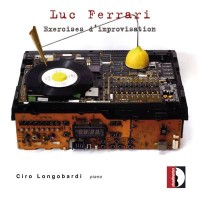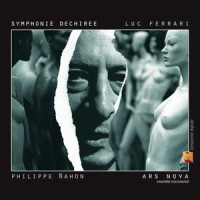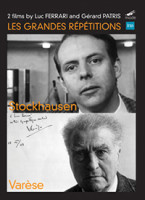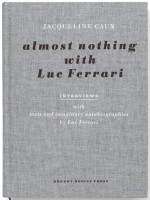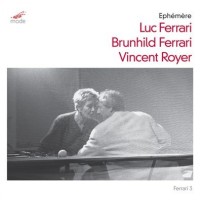Fresh Ferrari
|
Grant Chu Covell [November 2015.] Whether new or old, any Luc Ferrari is by nature fresh. Finally we have a book in English, and accessible releases of the films he worked on. His legacy continues through his widow Brunhild Ferrari and others.
Luc FERRARI: Exercises d’improvisation (1977); À la recherche du rythme perdu (1978). Ciro Longobardi (pno). Stradivarius STR 33968 (1 CD) (http://www.stradivarius.it/). A classical pianist, Longobardi stretched his comfort level to tackle the seven Exercises, originally intended for players who come from “the other side,” that is, a contemporary or jazz background. The booklet reprints the Exercises’ typewritten instructions (in French). The tape represents an agitated drone and a live player must engage with its tonality and constrained fidgeting through improvisation. Longobardi orders the exercises 1, 3, 5, 2, 6, 4 and 7. For several he offers shakes and trills that complement the tape’s anxiety, elsewhere he scatters oblivious arabesques. The tapes could be misunderstood as minimalist, however; they embody Ferrari’s “tautology” aesthetic where simultaneous rudimentary actions repeat asynchronously. Ferrari fans will recognize this example: the natural sound of crickets repeating over tapering sine waves. The tapes provide an intimidating backdrop because they are rich with personality and unfold deliberately. Longobardi establishes a new benchmark for À la recherche du rythme perdu, originally for piano, percussion and tape. Hardly a staple, the same tape also appears in Musique socialiste ou Programme commun which swaps piano for harpsichord. To compensate for the absent percussionist Longobardi offers interior sounds and prepares the piano slightly. Recherche is performed live and we hear applause at the end. The tape’s highest frequencies are slightly diminished. The 20-minute work is essentially a controlled crescendo and decrescendo. In an earlier recording (ADDA 581156 from 1989) Henry Fourès (piano) and Carlo Rizzo (percussion) confronted the tape. The notes reveal that there was actually no percussionist at the premiere, thus Longobardi is rediscovering an original realization. Longobardi is less frenzied than Fourès and Rizzo who freely give into slamming clusters and expansive paradiddles. Longobardi has provided a deft duo with a mirror.
Luc FERRARI: Symphonie Déchirée (1994-98). Ars Nova, Philippe Nahon (cond.). l’empreinte digitale EDVD733 (1 CD, 1 DVD) (http://www.empreintedigitale-label.fr/). “This symphony is a sort of balance between revolt and voluptuousness, realism and abstraction, impulsive and formalist movement.” Despite its title, this is not a symphony. However the title is accurate in that it is torn, or ripped, or broken. Scored for 17 instruments plus interfering “sons mémorisés” – Ferrari’s sly nomenclature for tape – Symphonie Déchirée offers eight episodes which stumble from singularity towards complexity. There are no preeminent motives; in fact, the absence of recurring themes encourages indifference. The movements are framed with pre-recorded material that often spills into or interrupts the instrumental sections. If it weren’t for the multi-lingual female announcer, it would be easy to lose track as movements abut. Composed in fits and starts, the hour-long piece embodies redirections and changes of mind. The longest parts make the greatest impression because of their insistence. Titles considered with their durations suggest a syllabus: Luc Ferrari: Symphonie Déchirée (1994-98)
Harmonic penetration begins with one held pitch increasingly subjected to ornaments and embellishments. Neighbor notes are added, gradually widening outwards. That the opening hints at Beethoven’s Ninth must be intentional. The ensemble quivers into life, as if each pitch must be forged anew. Play of objects offers tape interruptions including Ferrari speaking and a woman sighing (indubitably from Danses Organiques). Most of these movements are built using Ferrari’s tautology method (see above). Duality offers ticking percussion against a piano rich with flourishes, one of the first movements to be predominantly for this smaller group. Torn words attempts consolidation and growth. After the recorded train passes, Play of timbres reprises percussion and piano. In Play of reflections, the tape interrupts the intrepidly synchronizing ensemble. The orchestra imitates bells in the eponymous movement. We also hear a joke: the ripping sound adhesive tape makes when dispensed. The sound of tape on tape, get it? The finale, Tear (“laceration” declares the female announcer), possibly the most synchronized of the eight, tries valiantly for a culmination, building aggressively. However, expectations are thwarted as calmer material interrupts. And then it just stops, inconclusively. Ferrari finished the Symphonie at least twice, marking the score, “I’m stopping here, 18 October 1995,” and then just below, “Me too, 17 January 1997.” Obviously this is a private joke. Ferrari also wanted us to know that the unconventional, perhaps unsatisfying, work is incomplete. (Note that Ferrari did also work on a piece he titled Symphonie inachevée between 1963 and 1966.) The DVD mandates French fluency, as there are neither subtitles nor translations. Jacqueline Caux’s two-part video begins with Nahon discussing the work (11:45) and then we see a complete rehearsal (63:10), dated October 23, 2007, which would be the day before the performance on the CD. Two shorter films follow: Catherine Peillon’s L’Absent (12:14) and Déchirure (14:35), ruminations upon the Symphonie captured in 2012 and 2013.
Luc FERRARI and Gérard PATRIS: Les Grandes Répétitions: Karlheinz Stockausen: Momente (1965); Hommage à Edgard Varèse (1965). mode 276 (1 DVD) (http://www.moderecords.com/). I have been eager to see the Les Grandes Répétitions documentaries since first reading about them. Their five subjects are Olivier Messiaen, Edgard Varèse, Karlheinz Stockhausen, Hermann Scherchen, and Cecil Taylor each captured in rehearsal. Mode issues two of these black and white masterpieces, originally broadcast in April 1966 (Varèse) and June 1966 (Stockhausen). They do not disappoint. The mechanics and vocabulary of documentaries are commonplace today. Several of Ferrari and Patris’ techniques, possibly novel in 1965, are still effective: freely cutting between music and speaking, restless handheld cameras, and letting the subject lead the camera. The Stockhausen movie (45:49) is notable for an oblique view into Momente (1965). As the film starts, a roving Stockhausen directly addresses the camera in French (!) to share biographical details, and then the titles roll to reveal a rehearsal (with Martina Arroyo, soprano, and Alois and Alfons Kontarsky on electronic organs). We drop into the work at a point where Stockhausen asks the chorus for applause, which stops and starts according to his command. Over this music, Stockhausen is interviewed (again in French) as to the point of the prescribed applause. There is no introduction, Stockhausen speaks for himself, and the titles provide the barest of contexts. During the rehearsal, the camera is rarely ever still. Stockhausen makes for an effective if cool conductor. Nothing indicates how Stockhausen’s curious private life influenced the composition’s design and construction. The 60:20 Varèse film includes footage that must have been challenging: simultaneous video of Marcel Duchamp in New York City listening to Varèse’s music broadcast from Paris. The intention had been to film a rehearsal of Déserts with the composer present. However, Varèse died just days before filming began, and the rehearsal documentary instead became a tribute. The works included are Déserts (1954) and Ionisation (1931), conducted by Konstantin Simonovic and Bruno Maderna respectively. We hear Varèse speak (in French), including the great quote about how his music isn’t experimental but completely finished. We learn he prefers city noise to the country, that he was the first to bring industrial noise into the orchestra. Everyone is in awe of Varèse. The tributes flow in from Iannis Xenakis (who requests and receives a moment of silence), Konstantin Simonovic, Hermann Scherchen, Olivier Messiaen (wearing a busily patterned shirt and identified as “Messiaem” on the original credits), Ferdinand Ouellette (Varèse’s biographer), André Jolivet (at one time appearing to tear up), Pierre Boulez, Pierre Schaeffer, Bruno Maderna (disappointed with the percussion, desiring more brutality), and Marcel Duchamp (smoking a cigar). We get to see Ferrari himself asking questions to Duchamp, and Ionisation’s siren parts performed on ondes Martenots. During Déserts’ tape sections we glimpse shots of factories and New York City skyscrapers. Two out of five is an excellent start. Where are the remaining three?
Jacqueline CAUX: Almost Nothing with Luc Ferrari. Errant Bodies Press (2002; translated by Jérôme Hansen, 2013). ISBN 978-0-9827439-1-1 (http://www.errantbodies.org/). This little gray book offers “interviews with texts and imaginary autobiographies by Luc Ferrari.” Outstandingly attractive at 176 pages with a purple fabric-bound bookmark, there is no dust jacket, just a picture on the back of Ferrari crouching in a car trunk surrounded with recording equipment. It would be a disservice to Ferrari to read this book studiously from cover to cover. We read books about artists and creators to get to know them better. With Ferrari it’s best that some mystery hangs in the air. A multi-person interview, Ferrari and Caux with François Delalande, Daniel Terrugi and Evelyne Gayou, opens the book. Later chapters transcribe conversations between Caux and Ferrari. Sprinkled throughout are many of the fictional autobiographies Ferrari was wont to construct (several have appeared over the years as liner notes) and notes on his pieces. Ferrari was an oblique writer, indiscriminately combining facts with fantasy. His writing concerns itself with intentions and reminiscences rather than useful facts about the pieces. The music therefore stands on its own; any received confusion is assuredly intentional, not arbitrary. We learn about Ferrari’s encounters with key personalities of his time: Schaeffer, Stockhausen, Xenakis, et al. Perhaps made clear by retrospection, we learn his motivations and interests, how to find freedom from repetition, and how collecting sounds and then rearranging them can be political if not subversive. Ferrari seemed astonished that Presque Rien became a hit, but it’s suggested that he knew he was on to something. At the very least, he knew enough never to repeat it, despite successive works with similar titles. In all his endeavors he partnered with his wife Brunhild. There is a concluding worklist / discography.
Luc FERRARI: Éphémère (1974; ver. 2012). Brunhild FERRARI: Le Piano Englouti (2012). Vincent ROYER: Pour que le vent soit propice (2011; with the tape from Luc FERRARI’s Ce qu’a vu le Cers [1978]). Vincent Royer (vla, pno, perc, electronics). mode 285 (1 CD) (http://www.moderecords.com/). Royer is a restless musician. His earlier collaboration with Ferrari and pianist Jean-Philippe Collard-Nevin resulted in a powerful collection on Sub Rosa SR 261: Rencontres Fortuites (2003), Tautologos III (1969), and Didascalies (2004), not to mention Didascalies 2 (1993) on Sub Rosa SR 363-AB. (Yes, Didascalies 2 was written earlier; however, it was titled after the 2004 work came into being.) The fervor continues with a release in which Royer almost completely dissolves into Ferrari’s tapes. Éphémère can be for tape alone, or for tape with instruments. Ironically, the performers’ activities are ephemeral, whereas the tape is fixed. Alga marghen Plana-F 33NMN.081 documents two renditions (I, Nov. 1974, and II, the same month a year later). For this instantiation, Brunhild updated the work for Royer. Brunhild and Royer’s version is shorter (13:08) than either of the two on Alga marghen (27:03 and 51:35), however the piece’s duration is inherently flexible (my understanding is that I is tape alone and II adds electronically processed instruments). We are to understand that the Éphémère’s tape is like the sea, that the work ought to imitate the ocean. There are subtle loops and murmuring voices over an insistent, engulfing electronic buzzing drone on the original tape. Brunhild’s tape offers the essence of the content heard plainly in I. Royer is credited with just viola, although I think he also explores piano and percussion as well. His actions (delicate scratching on viola, interior piano sounds, bells) emerge out of the troughs in the cresting tape. Overall the progression is perkier and more compact than the mid-70s realizations. We quickly learn that Royer will rarely play the viola conventionally. Debussy hovers at the fringe, as we see in the titles and sources of Brunhild and Royer’s pieces. Le Piano Englouti and Pour que le vent soit propice / Ce qu’a vu le Cers both reference piano preludes (Book I, No. 10 and Book I, No. 7). Brunhild takes a more oneiric direction than perhaps Luc ever would. Le Piano Englouti is episodic with contrasts and pauses, begging an adventure story. Royer’s fidgeting viola emerges over dreamy textures. I am immediately struck that Brunhild is creating a place that never was whereas Ferrari took real locations and transformed them. The tape from Ce qu’a vu le Cers reflects nature, capturing sounds around Tuchan (a small town in France, also the kernel for a larger Luc and Brunhild multimedia work), birds, bells and insects with talking and crowd noises from a carnival. It’s meant to be a backdrop for an improvising ensemble, as in ADDA 581088, with the Le Vivant Quartet: Richard Breton, guitar, Jules Calmettes, flute and sax, Henry Fourès, piano, and Alain Joule, percussion. The older release (1988), 25:16 of “imaginary folklore,” has never been one of my favorites, though I suspect its trans-European, minstrel pseudo-jazz over basic repeating chord progressions was exactly what Ferrari was after, especially the pulsing tape which inspires a tango/polka. Royer explores a different path, avoiding riffs on invented nursery tunes, but instead creating varied episodes layering viola gestures in specific tessituras as Ferrari’s tape slowly unfurls beneath. Royer’s vision is 40:23, and I suspect we don’t first hear Ferrari’s tape until around the 11:30 mark. A big challenge is to introduce material that complements the tape without making everything sound foolish. The distorted carnival or calliope music around 26:00 is one such tricky place. Royer offers vocalizations, and loops his material creating effects such as high-pitched agitation sounding like angry seagulls. If it hasn’t been evident already, Royer is one of the best Ferrari proponents around.
[More Books, Grant Chu Covell]
[More
Ferrari, Meyer-Ferrari]
[Previous Article:
String Theory 13: 19 Quartets, etc.]
[Next Article:
Musica somnambulistica]
|
